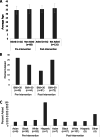Missed opportunities to prevent cardiovascular disease in women with prior preeclampsia
- PMID: 32998727
- PMCID: PMC7528479
- DOI: 10.1186/s12905-020-01074-7
Missed opportunities to prevent cardiovascular disease in women with prior preeclampsia
Abstract
Background: Cardiovascular disease (CVD) is the leading cause of death in women in every major developed country and in most emerging nations. Complications of pregnancy, including preeclampsia, indicate a subsequent increase in cardiovascular risk. There may be a primary care provider knowledge gap regarding preeclampsia as a risk factor for CVD. The objective of our study is to determine how often internists at an academic institution inquire about a history of preeclampsia, as compared to a history of smoking, hypertension and diabetes, when assessing CVD risk factors at well-woman visits. Additional aims were (1) to educate internal medicine primary care providers on the significance of preeclampsia as a risk factor for CVD disease and (2) to assess the impact of education interventions on obstetric history documentation and screening for CVD in women with prior preeclampsia.
Methods: A retrospective chart review was performed to identify women ages 18-48 with at least one prior obstetric delivery. We evaluated the frequency of documentation of preeclampsia compared to traditional risk factors for CVD (smoking, diabetes, and chronic hypertension) by reviewing the well-woman visit notes, past medical history, obstetric history, and the problem list in the electronic medical record. For intervention, educational teaching sessions (presentation with Q&A session) and education slide presentations were given to internal medicine physicians at clinic sites. Changes in documentation were evaluated post-intervention.
Results: When assessment of relevant pregnancy history was obtained, 23.6% of women were asked about a history preeclampsia while 98.9% were asked about diabetes or smoking and 100% were asked about chronic hypertension (p < 0.001). Education interventions did not significantly change rates of screening documentation (p = 0.36).
Conclusion: Our study adds to the growing body of literature that women with a history of preeclampsia might not be identified as having increased CVD risk in the outpatient primary care setting. Novel educational programming may be required to increase provider documentation of preeclampsia history in screening.
Keywords: Cardiovascular disease; Hypertensive disease of pregnancy; Preeclampsia; Primary prevention.
Conflict of interest statement
The authors declare that they have no competing interests.
Figures



References
-
- Bellamy L, et al. Pre-eclampsia and risk of cardiovascular disease and cancer in later life: systematic review and meta-analysis. BMJ. 2007;335(7627):974. doi: 10.1136/bmj.39335.385301.BE. - DOI - PMC - PubMed
-
- Brown HL, et al. Promoting risk identification and reduction of cardiovascular disease in women through collaboration with obstetricians and gynecologists: a presidential advisory from the American Heart Association and the American College of Obstetricians and Gynecologists. Circulation. 2018;137(24):e843–e852. doi: 10.1161/CIR.0000000000000582. - DOI - PubMed
MeSH terms
LinkOut - more resources
Full Text Sources
Medical
Miscellaneous

